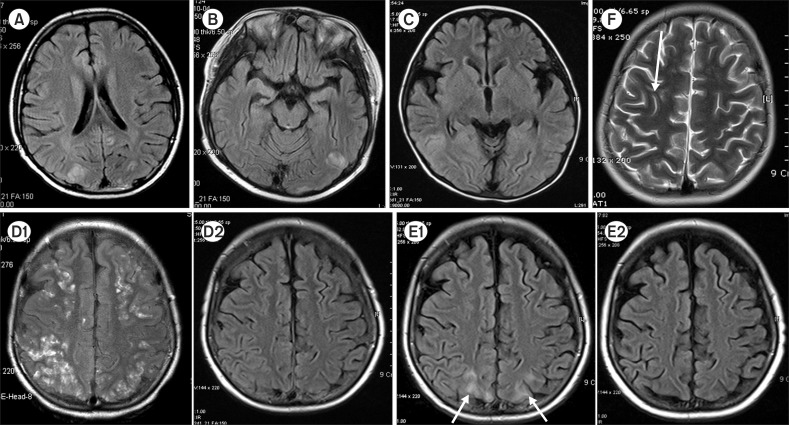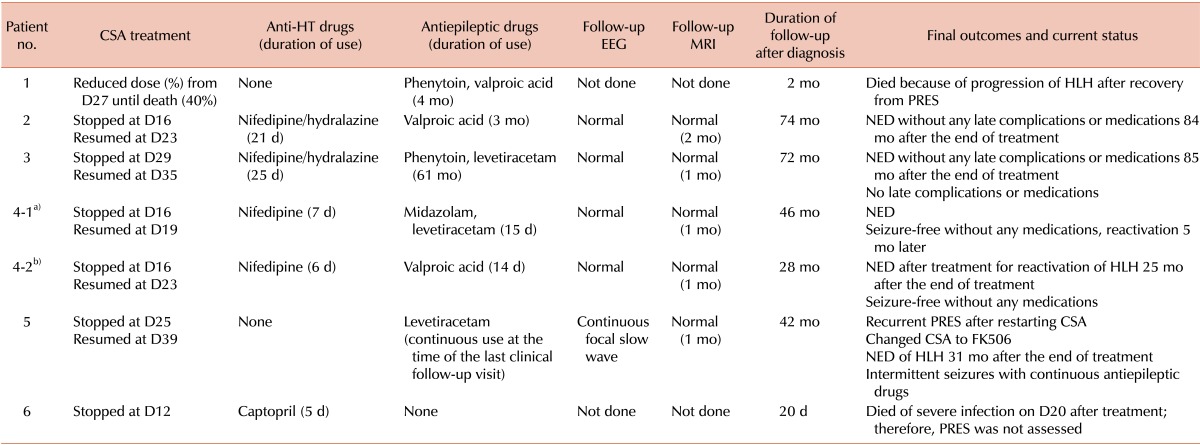1. Hinchey J, Chaves C, Appignani B, et al. A reversible posterior leukoencephalopathy syndrome. N Engl J Med. 1996; 334:494–500. PMID:
8559202.

2. Wirrell EC, Hamiwka LD, Hamiwka LA, Grisaru S, Wei X. Acute glomerulonephritis presenting with PRES: a report of 4 cases. Can J Neurol Sci. 2007; 34:316–321. PMID:
17803029.

3. Thackeray EM, Tielborg MC. Posterior reversible encephalopathy syndrome in a patient with severe preeclampsia. Anesth Analg. 2007; 105:184–186. PMID:
17578974.

4. El Karoui K, Le Quintrec M, Dekeyser E, et al. Posterior reversible encephalopathy syndrome in systemic lupus erythematosus. Nephrol Dial Transplant. 2008; 23:757–763. PMID:
18056072.

5. Bartynski WS, Boardman JF, Zeigler ZR, Shadduck RK, Lister J. Posterior reversible encephalopathy syndrome in infection, sepsis, and shock. AJNR Am J Neuroradiol. 2006; 27:2179–2190. PMID:
17110690.
6. Fuchigami T, Inamo Y, Hashimoto K, et al. Henoch-schonlein purpura complicated by reversible posterior leukoencephalopathy syndrome. Pediatr Emerg Care. 2010; 26:583–585. PMID:
20693857.
7. Ozcakar ZB, Ekim M, Fitoz S, et al. Hypertension induced reversible posterior leukoencephalopathy syndrome: a report of two cases. Eur J Pediatr. 2004; 163:728–730. PMID:
15322868.

8. Endo A, Fuchigami T, Hasegawa M, et al. Posterior reversible encephalopathy syndrome in childhood: report of four cases and review of the literature. Pediatr Emerg Care. 2012; 28:153–157. PMID:
22307182.
9. Kim SJ, Im SA, Lee JW, et al. Predisposing factors of posterior reversible encephalopathy syndrome in acute childhood leukemia. Pediatr Neurol. 2012; 47:436–442. PMID:
23127265.

10. de Laat P, Te Winkel ML, Devos AS, Catsman-Berrevoets CE, Pieters R, van den Heuvel-Eibrink MM. Posterior reversible encephalopathy syndrome in childhood cancer. Ann Oncol. 2011; 22:472–478. PMID:
20699277.

11. Gumus H, Per H, Kumandas S, Yikilmaz A. Reversible posterior leukoencephalopathy syndrome in childhood: report of nine cases and review of the literature. Neurol Sci. 2010; 31:125–131. PMID:
19809787.

12. Won SC, Kwon SY, Han JW, Choi SY, Lyu CJ. Posterior reversible encephalopathy syndrome in childhood with hematologic/oncologic diseases. J Pediatr Hematol Oncol. 2009; 31:505–508. PMID:
19564746.

13. Morris EB, Laningham FH, Sandlund JT, Khan RB. Posterior reversible encephalopathy syndrome in children with cancer. Pediatr Blood Cancer. 2007; 48:152–159. PMID:
16317748.

14. Gupta A, Swaroop C, Rastogi R, Garg R, Bakhshi S. Simultaneous occurrence of posterior reversible leukoencephalopathy syndrome in two cases of childhood acute lymphoblastic leukemia induction chemotherapy. Pediatr Hematol Oncol. 2008; 25:351–358. PMID:
18484481.

15. Saeed B, Abou-Zor N, Amer Z, Kanani I, Hilal M. Cyclosporin-A induced posterior reversible encephalopathy syndrome. Saudi J Kidney Dis Transpl. 2008; 19:439–442. PMID:
18445907.
16. Yokobori S, Yokota H, Yamamoto Y. Pediatric posterior reversible leukoencephalopathy syndrome and NSAID-induced acute tubular interstitial nephritis. Pediatr Neurol. 2006; 34:245–247. PMID:
16504799.

17. Hourani R, Abboud M, Hourani M, Khalifeh H, Muwakkit S. L-asparaginase-induced posterior reversible encephalopathy syndrome during acute lymphoblastic leukemia treatment in children. Neuropediatrics. 2008; 39:46–50. PMID:
18504683.

18. Filipovich AH. Hemophagocytic lymphohistiocytosis and other hemophagocytic disorders. Immunol Allergy Clin North Am. 2008; 28:293–313. PMID:
18424334.

19. Thompson PA, Allen CE, Horton T, Jones JY, Vinks AA, McClain KL. Severe neurologic side effects in patients being treated for hemophagocytic lymphohistiocytosis. Pediatr Blood Cancer. 2009; 52:621–625. PMID:
19137570.

20. Henter JI, Horne A, Arico M, et al. HLH-2004: Diagnostic and therapeutic guidelines for hemophagocytic lymphohistiocytosis. Pediatr Blood Cancer. 2007; 48:124–131. PMID:
16937360.

21. Henter JI, Nennesmo I. Neuropathologic findings and neurologic symptoms in twenty-three children with hemophagocytic lymphohistiocytosis. J Pediatr. 1997; 130:358–365. PMID:
9063409.

22. Yakushijin K, Mizuno I, Sada A, et al. Cyclosporin neurotoxicity with Epstein-Barr virus-associated hemophagocytic syndrome. Haematologica. 2005; 90:ECR11. PMID:
15753052.
23. Bartynski WS, Tan HP, Boardman JF, Shapiro R, Marsh JW. Posterior reversible encephalopathy syndrome after solid organ transplantation. AJNR Am J Neuroradiol. 2008; 29:924–930. PMID:
18272559.

24. Pavlakis SG, Frank Y, Chusid R. Hypertensive encephalopathy, reversible occipitoparietal encephalopathy, or reversible posterior leukoencephalopathy: three names for an old syndrome. J Child Neurol. 1999; 14:277–281. PMID:
10342593.
25. Eguchi K, Kasahara K, Nagashima A, et al. Two cases of malignant hypertension with reversible diffuse leukoencephalopathy exhibiting a reversible nocturnal blood pressure "riser" pattern. Hypertens Res. 2002; 25:467–473. PMID:
12135328.

26. Norman JK, Parke JT, Wilson DA, McNall-Knapp RY. Reversible posterior leukoencephalopathy syndrome in children undergoing induction therapy for acute lymphoblastic leukemia. Pediatr Blood Cancer. 2007; 49:198–203. PMID:
16123992.

27. Truwit CL, Denaro CP, Lake JR, DeMarco T. MR imaging of reversible cyclosporin A-induced neurotoxicity. AJNR Am J Neuroradiol. 1991; 12:651–659. PMID:
1882738.
28. Irvin W, MacDonald G, Smith JK, Kim WY. Dexamethasone-induced posterior reversible encephalopathy syndrome. J Clin Oncol. 2007; 25:2484–2486. PMID:
17557962.

29. Torelli GF, Natalino F, Barberi W, et al. Early onset of posterior reversible encephalopathy syndrome (PRES) during Cyclosporine-A infusion. Leuk Res. 2011; 35:1423–1424. PMID:
21397327.

30. Bechstein WO. Neurotoxicity of calcineurin inhibitors: impact and clinical management. Transpl Int. 2000; 13:313–326. PMID:
11052266.

31. Wong R, Beguelin GZ, de Lima M, et al. Tacrolimus-associated posterior reversible encephalopathy syndrome after allogeneic haematopoietic stem cell transplantation. Br J Haematol. 2003; 122:128–134. PMID:
12823354.








 PDF
PDF ePub
ePub Citation
Citation Print
Print




 XML Download
XML Download